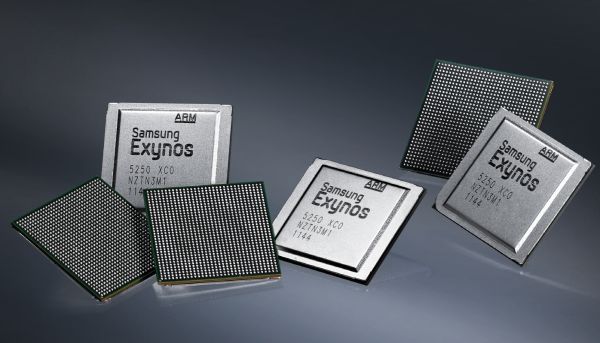Samsung Exynos 5250 Announced: Cortex-A15, 2GHz, Dual-core
by Jason Inofuentes on November 30, 2011 10:59 AM EST- Posted in
- Samsung
- Cortex A15
- Exynos
- Laptops
- PowerVR
All our favorite mobile System-on-Chip manufacturers have been hard at work on their Cortex-A15 designs, and Samsung is no different. Today, in Korea, Samsung announced their first Cortex-A15 SoC, the Exynos 5250. Clocked at 2 GHz and produced with a 32 nm process, the chip should offer competitive per core performance as the Qualcomm and TI designs that will be rolling out in 2012; unlike Tegra 3, though, it appears the first shipping product will be dual-core.
Compute performance is expected to double over their 1.5 GHz Cortex-A9 based Exynos processors, and memory bandwidth is quoted as 12.8 GB/s, a huge jump over their prior bandwidth. Unfortunately the release didn't clarify the origin of the bandwidth leap. It also didn't discuss the on package GPU. Graphics performance will reportedly quadruple over their earlier Exynos models, which could eclipse the current graphics king, Apple's A5 SoC.
New power-saving tech involves a low-power frame buffer for static screens, potentially allowing the GPU to be fully powered down when displaying just a home screen or other static image. The GPU will have to be pretty beefy to push the WQXGA (2560x1600) resolution targeted for next generation tablet displays. Hummingbird used PowerVR, Exynos used Mali, and though Samsung has access to other ARM-Mali designs they haven't used yet, they also recently licensed PowerVR's latest GPU designs. We're reaching out to our sources for more information and will update as necessary.
Source: Samsung (Korea)











23 Comments
View All Comments
biassj - Wednesday, November 30, 2011 - link
So Galaxy S III =1080 screen and plays Crysis?SimpleLance - Wednesday, November 30, 2011 - link
A15: 3-issue, 15-stage pipelineA9: 2-issue, 8-stage pipeline
ARM estimates that the A15 is 40% faster than the A9 for the same clock speed.
tyger11 - Wednesday, November 30, 2011 - link
I'd love to see what kind of power draw they could get down to by making this at 22nm. Sure, Ivy Bridge will be great and all, but the chips that really need to be built on such a small process are mobile chips.JasonInofuentes - Wednesday, November 30, 2011 - link
That's an interesting thought, but imagine what kind of a power hungry, hot mess Sandy Bridge was if it was twice as big as it is now. The cutting edge will for some time be PC CPUs, because their higher IPC is a result of higher transistor counts. Plus, PCs remain where most computing happens. At some point, as more and more computing is done in the mobile space, then node parity between ARM and x86 might happen. If it does, though, Intel and AMD had better have designs that transcend their current performance envelopes, because their performance per watt is still nowhere near ARM designs.etamin - Wednesday, November 30, 2011 - link
Does anyone have a guess as to how powerful these SoCs are vs older desktop chips like Pentium III or Pentium 4 maybe?SimpleLance - Wednesday, November 30, 2011 - link
When I tested the same single-threaded chess code on an HTC HD2 (1Ghz A8 ARM) and on a 2.3Ghz, Core2-duo, the C2D was 3 times faster.This means that the newer A15 will be faster than a Core2, for the same clock speed.
Exodite - Wednesday, November 30, 2011 - link
Kinda depends a lot on what instructions you use though, doesn't it?The x86 instruction space, all extensions included, is vast and while that's often a disadvantage I'd imagine it would widen the gap considerably if taken advantage of properly.
Personally I find it difficult to believe that even the Cortex A15 could hope to approach the same IPC as C2D.
tipoo - Thursday, December 1, 2011 - link
I was just about to say that, I'll bet the code didn't use the x86 extensions available in the Core 2 Duo otherwise it would be much faster.psychobriggsy - Wednesday, November 30, 2011 - link
With over 1000 balls on that BGA, we're talking about a significantly higher-end chip than your average mobile processor! I guess that it has off-chip DRAM (via SO-DIMMs) rather than stacked on die, and a lot of those balls are memory interface connections.The graphics sound like they'll be twice as powerful as the ones on the A5, certainly more than adequate for 2012's tablets and ARM netbooks / ultrabooks. And possibly Android-based media hubs that can also play games (because Apple TV 3 will surely do that soon).
Wonder what the power consumption is...
rd_nest - Thursday, December 1, 2011 - link
How many SoC would Sammy make?I understand that 4412 would be Quad Core. AFAIK, all of them use 32nm fab. But what's the difference (benchmark/practical usage) between all these SoC?
Off-topic: Do Samsung allow it's employees to take vacation or week-offs?